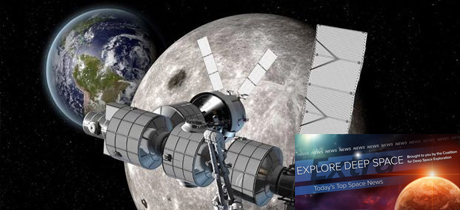In Today’s Deep Space Extra… The U.S. and Russia find possible post International Space Station common ground in NASA’s proposed Deep Space Gateway (DSG). A human tended lunar orbiting space station, the DSG would help prepare for the future human exploration of Mars.
Human Space Exploration
NASA, Roscosmos sign joint statement on researching, exploring deep space
NASA (9/27): Russia and NASA have agreed to work on the formulation and development of a Deep Space Gateway (DSG), a human lunar orbiting spacecraft that could prepare global partners and private industry for further deep space exploration. “While the deep space gateway is still in concept formulation, NASA is pleased to see growing international interest in moving into cislunar space as the next step for advancing human space exploration,” said Robert Lightfoot, NASA’s acting administrator.
NASA and Russia partner up for crewed deep-space missions
Space.com (9/27): NASA and Roscosmos, the Russian federal space agency, announced plans Wednesday to cooperate on NASA’s proposed Deep Space Gateway (DSG), a human lunar orbiting space station that could be assembled in lunar orbit during the 2020s to prepare for future missions to Mars and possibly the lunar surface.
NASA, Russia agree to studies, standards setting for future human space missions
Spacepolicyonline.com (9/27): The post-Cold War teamwork in space forged by the U.S. and Russia could live on in the development of NASA’s proposed Deep Space Gateway (DSG), a crewed lunar orbiting space station. The DSG, though yet to be endorsed by the White House or Congress, could function as a proving ground for hardware and humans preparing to explore Mars.
Space Science
University of Arizona professor, new space telescope rode out hurricane in Houston
Arizona Daily Star (9/27): The NASA led James Webb Space Telescope, successor to the 27-year-old Hubble Space Telescope, has been undergoing a critical thermal vacuum test at NASA’s Johnson Space Center in Houston, Texas since July. The test coincided with Hurricane Harvey’s flooding rains.
Hurricane damage threatens Arecibo Observatory’s future
Science (9/26): Puerto Rico’s large Arecibo radio telescope sustained moderate damage as Hurricane Maria swept the region last week. However, some scientists are worried that even a positive prognosis in the storm’s aftermath may be too much to keep the telescope operational in the long run.
215 million Americans watched the total solar eclipse, study finds
New York Times (9/27): A University of Michigan collaboration with NASA has determined the 215 million adult Americans, or 88 percent of the total U.S. adult population observed the August 21 total solar eclipse — either directly or by electronic media.
Long-ago smashups could explain Earth’s weird composition
Space.com (9/27): Studies of changes in mineral composition of the rocks from Earth and Martian meteorites suggest that early collisions with smaller planetary bodies called planetesimals may have altered the makeup of the solar system’s rocky planets.
Fourth gravitational wave event detected
Sky and Telescope (9/27): For the first time, three observatories have detected the same gravitational wave, ripples in space time predicted by Albert Einstein a century ago and believed to emanate from the merging of black holes. The August 14 observations were reported in the journal Physical Review Letters. The detectors are located in Livingston, Louisiana, Hanford, Washington, and Pisa, Italy.
Other News
Scientists celebrate 10th anniversary of Dawn mission’s launch
Spaceflightnow.com (9/27): Wednesday marked the 10th anniversary of NASA’s Dawn mission launch. Currently orbiting the main belt asteroid and dwarf planet Ceres, Dawn is the first spacecraft to orbit two solar system bodies. The spacecraft’s first stop was the large asteroid, Vesta, from 2011-12.
NASA’s near-Earth asteroid cubesat goes full sail
Space Daily (9/27): At NASA’s Marshall Space Flight Center, a large cubesat set to launch as part of the agency’s first Space Launch System mission has passed a test of its solar sail deployment system. The sail is about as large as a school bus.

